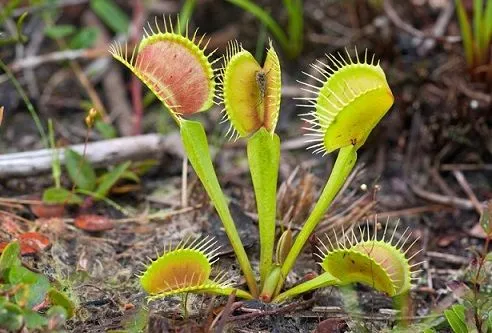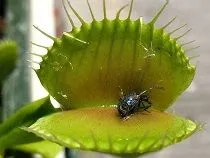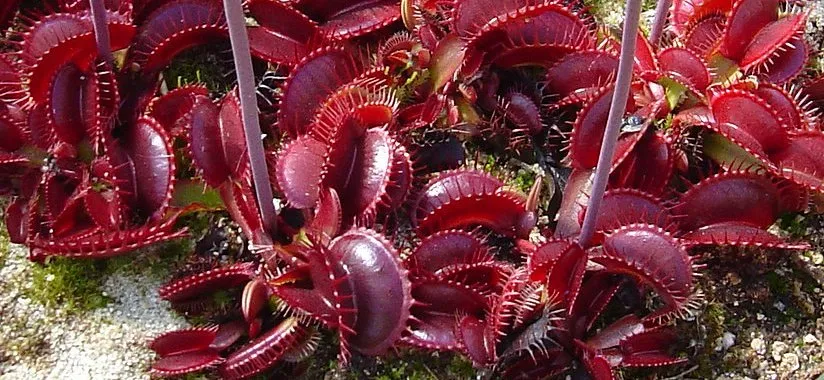Just like I told you guys in my introduction, the venus flytrap happens to be my favourite plant, was watching a show on this plant some days ago, so I decided to share with the steemit community a little research on the venus flytrap, its unfortunate that this beauty is known to be one of the vulnerable plants in the plant world which is mainly due to some reasons which will be shared in this article, so join me as we take a tour on the venus flytrap

Source
An Essence Of Beauty
This is a plant with a structure of four to seven leaves arising from a short stem bulb-like in nature. The stem of a Venus Flytrap is about 3-5 centimetres each, but this size ranges due to the time of the year. Leaves of longer size and robust traps are formed after flowering of the Venus flytrap.
As earlier stated, flytraps can have up to seven leaves, but when the leaves are above seven, this is usually caused by rosettes division in the ground
The blade of the Venus flytrap has two regions which include the heart-shaped, flat petiole and a terminal love hinge which is at midrib of this plant which can also be termed as the true leaf.
Holes are located in the meshwork which allows a small prey escape; this is probably because the Venus flytrap presumes that the benefit which would be obtained from this animal would be less due to its size than the time it will take to digest it. When prey is small in size and escapes, the trap will open once more after 12 hours, but when the animal moves around, digestion begins after it tightens.
The upper surface of the Venus flytrap lobes is seen to have a red anthocyanins pigment, and the edge of the lobes secrete mucilage. A rapid plant movement is noticed by its lobes which gives a snap shut after being stimulated by its prey.
There exist three hair-like trichomes which begin the trapping mechanism; they can be found on the surface of the lobe. The trapping mechanism exhibited by this species of plant is special such that it knows the difference between living prey and non-prey type stimuli which can be a raindrop.Venus flytrap petiole shape is of different shape and the leaves can either lie flat or extend in different angles ranging from 40-60 degree.
THEIR CARNIVORY NATURE
Animals They Feed On
Just like other carnivorous plants, they select their prey to feed on. Selection of prey is based on the availability of prey, and it's trapping mechanism. When the Venus flytrap is mentioned, prey selection is limited to spiders, beetles and some crawling arthropods. Based on statistics, Their Prey is 30 percent for spiders, 10 percent for beetles, 10 percent for grasshoppers and 33 percent for ants with some few flying insects taking 5 percent of its feed.
Since they are said to evolve from a carnivorous plant which uses a sticky trap called the Drosera, the Venus flytrap evolution becomes clear, since the Drosera tend to consume smaller insects and the Dionaea can consume larger ones. This gives them an advantage over the sticky trap as they get more nutrients from their prey.
How They Trap And Digest Their Prey
They are among a very small plant group which exhibit fast movement. On each side of the lobes there exists about 3-4 sensor hair which is not long, about 0.2 inches. To capture an insect, the insect will need to trip on a hair twice also if two hairs are tripped on within twenty-second there is shutting off the trap. This is to avoid unnecessary shutting of the traps by false alarm or raindrop.
When a hair is triggered, electric signals tend to travel along the trap surface which is more like that that travels within an animal nerve. The trap stores that first energy and waits for the next. When a second touch is given another electric signal is generated which combines with the first to pass the needed threshold to resume the trap sequence.
After the second touch, water is lost by cells in the centre of the lobes which cause cells lose turgor and the pressure which keeps the plant rigid we lost. Thus the lobes tend to snap together.
After trapping if it's prey, the Venus flytrap turns the trap to an external stomach which seals it to get no air from The environment, and no air is lost from it too. glands in the trap hence produce enzymes needed to digest
It takes several days to digest which all depends on the size of the insect after which the leaves open up once more, this time, the prey is a skeleton which can be blown away.
Where They Are Mostly Found
They can be found mostly in environments with poor nitrogen and phosphorus levels such as wet Savannahs and bogs. They are small and slow growing plants which can tolerate fire very well, and they only deepen on periodical burning to suppress them, and this tends to threaten its continuity in the wild. They can survive in Pratt and wet sandy soils though they have successfully been transplanted and cultivated in most local areas.

Source: The venus flytrap in its habitat
The Venus flytrap is native to coastal bogs of the North and South Carolina of the United States. One major growth area is the Green Swamp of North Carolina. They can also be found in North Florida as well as Western Washington.
One major criterion for their habitat is the poverty level of soil nutrition which helps elaborate the traps. Nitrogen for their need for protein is provided by the insects they catch which the soil cannot get them. The Venus flytrap is not a tropical plant. Hence they tend to have a tolerant level for winter, hence, any who do not survive the winter period die after some time.
They Risk Extinction In The Wild
Today, the Venus flytrap is classified as a vulnerable species near extinction by National Wildlife Federation. The estimated total value in 2015 sees 33,000 of this plant within 75 miles of its known habitat in the city of Wilmington of North Carolina and also cultivation sites controlled by Nature Conservancy, the US military and the State Government of North Carolina.
They disappeared From most locations due to fire suppression and starving them of the sunlight needed to keep them alive. As of today, the Venus Flytrap can only be seen in few sites majorly those managed by Nature Conservancy
A Senate bill was passed in North Carolina in 2014 classifying theft of any natural growing flytrap a felony. More penalties and sanctions were made for theft of this plant in December of 2014.
Some Fact On The Venus Flytrap
They Probably Might Have Gotten Their Name After Lady-Parts: In the Roman mythology, Venus was known to be the goddess of love and Dione, equivalent for the Greeks, they are responsible for the plant name with Dionaea being its genus name. Early explorers were reminded of gaping vaginas when the set eyes on this plant.
Charles Darwin Admired Them: in 1875, he wrote, "is the most wonderful plant in the world". He dedicated himself to writing a book of plants which eat insect where he gave the illustration about this plant.
They Lure Their Prey With Necter: They secrete nectar which has quite a sweet smell to lure hungry invertebrates, some plants of this species make use of the same procedure to lure prey then ensnare.
They Also Glow Blue: Apart from using their nectar to lure prey, they also emit fluorescent blue glows. Hence bugs are attracted, this occurs mostly during the bleaker part of a day.
They Can Feed On Human Flesh: No plant feed on people, but the Venus flytrap can digest human skin when placed in its pod.
Science Have Develope Red Flytrap: Due to captive breeding of the Venus flytrap, more of this specimen is in greenhouses and clay pots than there is in the wild, this has made possible the creation of some subspecies some maroon, crimson and burgundy, notable to the species named Alain Ryu after the Japanese Red Dragons
What I Have To Say
Just like you can notice, the venus flytrap is quite a beautiful plant, and with its nature, many would want to keep this plants as pets in their homes thus recently, there has been a decline in the venus flytrap which is caused by the abuse of this plant.
Though a lot is being done now to conserve this species of plant, I feel more should be done for the plant world in general as this is just one of the many plants which have been abused by humans either leading to their vulnerability or at worst their extinction
This Is The Venus Flytrap In Action
This is also a call against deforestation of forests. The issue of deforestation though have seen to have effects on animals also have its effect on plants and the ecosystem in general; therefore for continuity of life and better earth, we should find a balance between industrialisation, the need for landmass and the plant world in general.
Was introduced to the steemstem community when i arrived here and i must say its a wonderful, actually the best on steemit, the learning, information and all, its nice writing my first research work here.
Thanks to @whileponderin for the heads up on how to go about writing here on Steemstem, its just lovely :)
Thanks For reading this piece, we can keep doing this :)
Refrence
The Venus Flytrap
General Facts On The Venus Flytrap
Venus Flytrap Risk Extinction in The Wild





